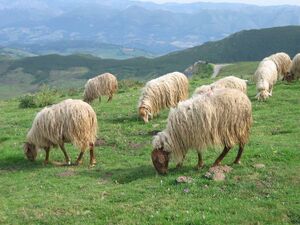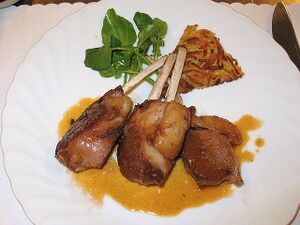
Looking for Lamb & mutton recipes?
- You'll find our lamb recipe section here
- You'll find our mutton recipe section here
- Our slow roast recipes are here
- If the cost of a whole leg of lamb is restrictive, take a look in the supermarket freezer cabinet.
Domestic sheep (Ovis aries) are four-legged, ruminant mammals typically kept as livestock. Although the name "sheep" applies to many species, in everyday usage it almost always refers to Ovis aries. Numbering a little over 1 billion, domestic sheep are the most numerous species in their genus. In many eastern countries including India, Pakistan, Bangladesh, Malaysia and Singapore the term mutton refers to goat's meat (which is also called chevon) and usually not to sheep's meat.
Classifications
Because of dramatically differing economic values of each type of animal (lamb being the most expensive), classification systems have developed to ensure consumers receive the product they have purchased. The strict definitions for lamb, hogget and mutton vary considerably between countries. In New Zealand for example, they are defined as follows:
- Lamb — a young sheep under 12 months of age which does not have any permanent incisor teeth in wear
- Hogget — a young male sheep or maiden ewe having no more than two permanent incisors in wear
- Mutton — a female (ewe) or castrated male (wether) sheep having more than two permanent incisors in wear.

In Australia the definitions are extended to include ewes and rams, as well as being stricter on the definition for lamb which is:
- Lamb — 0 permanent incisors; female or castrate entire male ovine 0-12 months (note that the Australian definition requires 0 permanent incisors, whereas the New Zealand definition allows 0 incisors 'in wear'.)
The younger the lamb is, the smaller the lamb will be, however, the meat will be more tender. Sheep mutton is meat from a sheep over two years old, and has a less tender flesh. In general, the darker the colour, the older the animal. Baby lamb meat will be pale pink, while regular lamb is pinkish-red.
Other definitions include:
- Lamb — a young sheep that is less than one year old
- Baby lamb — a milk-fed lamb between six and eight weeks old
- Spring lamb — a milk-fed lamb, usually three to five months old, born in late winter or early spring and sold usually before July 1st
- Yearling lamb — a young sheep between 12 and 24 months old.
- Milk-fed lamb — meat from an unweaned lamb, typically 4 to 6 weeks old and weighing 5.5 to 8 kg; this is almost unavailable in countries such as the USA and the UK, where it is considered uneconomic. The flavour and texture of milk-fed lamb when grilled (such as the tiny lamb chops known as chuletillas in Spain) or roasted (lechazo asado or cordero lechal asado) is generally thought to be finer than that of older lamb. The areas in northern Spain where this can be found include Asturias, Cantabria, Castile and León, and La Rioja. Milk-fed lambs (and kids) are especially prized for Easter in Greece, when they are roasted on a spit.
- Sucker lambs — a term used in Australia — includes young milk-fed lambs as well as slightly older lambs up to about 7 months of age which are also still dependent on their mothers for milk. Carcases from these lambs usually weigh between 14 and 30kg. Older weaned lambs which have not yet matured to become mutton are known as old-season lambs.

- Salt marsh lamb (also 'Saltmarsh lamb') — the meat of sheep which graze on salt marsh in coastal estuaries that are washed by the tides and support a range of salt-tolerant grasses and herbs such as samphire, sparta grass, sorrel and sea lavender. Depending on where in the world the salt marsh is located, the nature of the plants may be subtly different. Salt marsh lamb has long been appreciated in France and is growing in popularity in the United Kingdom. Places where salt marsh lamb are reared in the UK include Harlech and the Gower peninsula in Wales, the Somerset Levels and Morecambe Bay.
Sheep's milk may have been drunk in antiquity, though today is used predominantly in cheese and yogurt. Sheep have only two teats, and produce a far smaller volume of milk than cows. However, as sheep's milk contains far more fat, solids, and minerals than cows' milk, it is ideal for the cheese-making process. It also resists contamination during cooling better because of its much higher calcium content. Well-known cheeses made from sheep milk include the Feta of Bulgaria and Greece, Roquefort of France, Manchego from Spain, the Pecorino Romano (the Italian word for sheep is pecore) and Ricotta of Italy. Yogurts, especially some forms of strained yogurt, may also be made from sheep milk. Many of these products are now often made with cows' milk, especially when produced outside their country of origin. Sheep milk contains 4.8% lactose, which may affect those who are intolerant.
Lamb cutlets

In British cuisine a cutlet is usually unbreaded. It can also be called a chop.
Lamb cutlets can be served French trimmed for decorative purposes.
See also
How much does one cup of lamb weigh?
Estimated US cup to weight equivalents:
| Ingredient | US Cups | Grams | Ounces |
|---|---|---|---|
| Raw Minced Lamb | 1 Cup | 225 g | 8 oz |
| Cooked Minced Lamb | 1 Cup | 150 g | 5.5 oz |
Conversion notes:
Every ingredient has a cups to ounces or grams conversion table. Search for the ingredient, cup to weight conversions are at the end of each ingredient page.
We also have a generic conversion table and a portions per person lookup.
Seasonal Information: Sheep
This information is specifically for countries in the northern temperate zone of the Northern Hemisphere; particularly the United Kingdom, however it should be applicable for northern USA, northern Europe, Canada, Russia, etc.
Sheep is at its best and in season during the following months: May, June, July, August, September & October.
See also
- Goats
- Mutton
- Slow-roast recipes
- Safe meat cooking temperature (lamb/mutton)
- Frozen lamb - what great value!
Find recipes that contain 'Sheep'
#sheep #mutton #cowsmilk #cheese #cows #lactose #samphire #ricotta #frenchtrimmed #isleofmanmanxloaghtanlamb #welshlamb